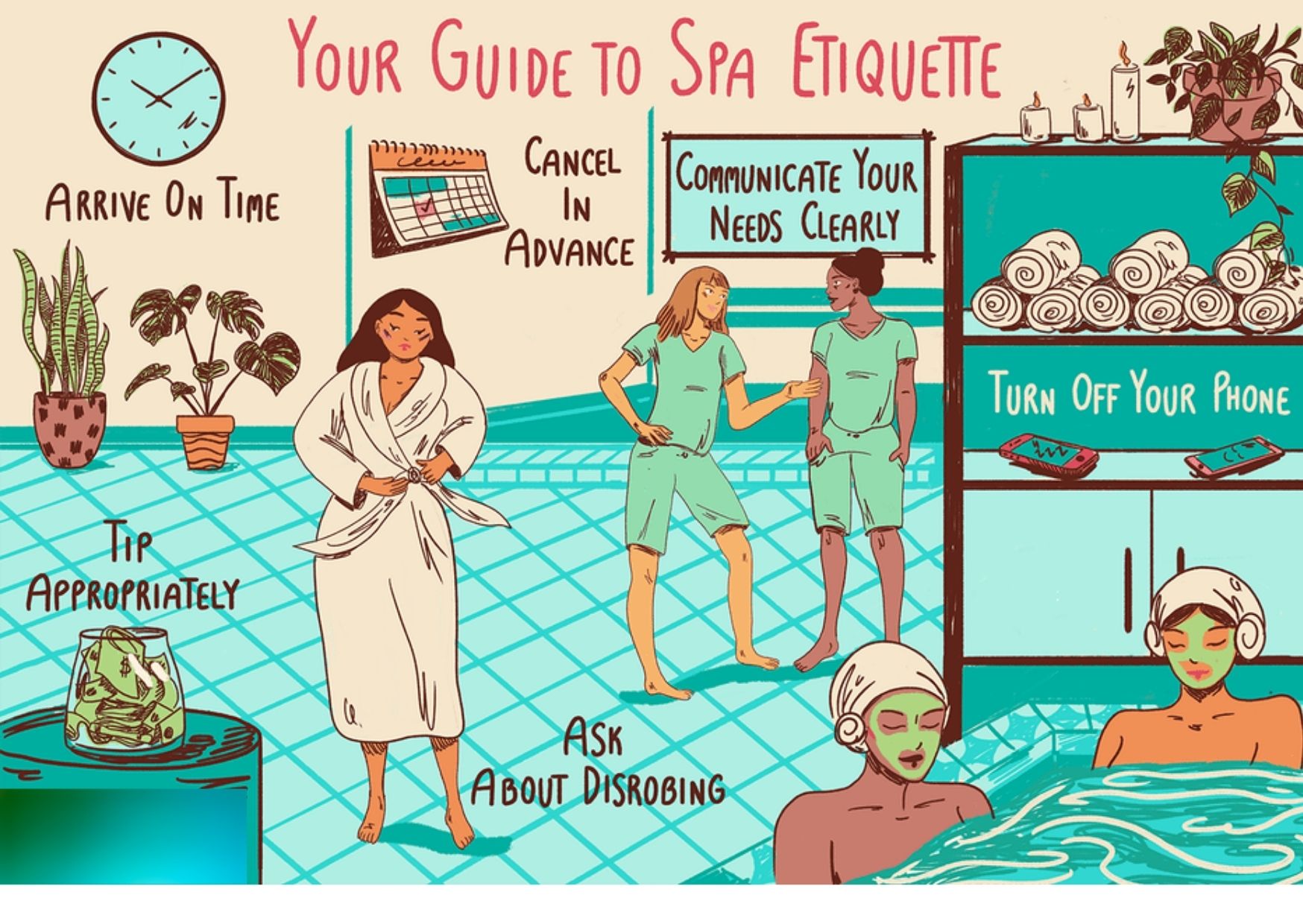Your Ultimate Spa Etiquette Guide - Things You Need To Know Before Going To One
Spa etiquette can be a source of anxiety for first-time spa-goers, but it's easy once you know a few basics. Here are some basic rules of spa etiquette to help you know what to expect and feel at ease.
Author:Stefano MclaughlinReviewer:Karan EmeryDec 30, 202223.3K Shares396.5K Views

Spa etiquette can be a source of anxiety for first-time spa-goers, but it's easy once you know a few basics. Here are some basic rules of spa etiquette guideto help you know what to expect and feel at ease.
Spa Etiquette Guide
Turn Off Your Cell Phone
Most spas won't allow you to bring your cell phone to the spa. You can't relax if you're answering calls, checking emails, and texting in the spa and neither can the person next to you. Sometimes it's okay to text or check emails while you're getting a pedicure but refrain from conversations.
Arrive On Time
How much earlier to arrive ahead of your appointment depends on what kind of spa it is, whether you've been before, and what kind of experience you want to have. Ten or 15 minutes can be enough for a basic day spa without amenities like locker rooms, robes, steam, and sauna. You may need a few minutes to fill out paperwork the first time.
You don't need to arrive too far in advance if all you're going to do is take your clothes off in the treatment room. Just leave yourself plenty of time to get there. There's nothing more stressful than racing to a massage. Better to get there a little early and relax than to get there late and miss part of your treatment.
Get there at least 20 to 30 minutes sooner if it's a larger, upscale day spa, a resort spa, a hotel spa, or a destination spa. There may be people in front of you, and you need time to fill out paperwork, get a tour of the facilities, change into your robe, and enjoy amenities like a steam room or hot tub.
Ask about the amenities when you make your appointment and think about what you would like to experience. Time to unwind in the steam room or hot tub? It will help relax you before your massage. A dip in the resort spa's pool before you change into your robe and slippers? An exercise class? There's a lot of variations, so you want to know what the spa offers before. If you get there ten minutes before your appointment, you're just shortchanging yourself.
If there's a shower in the locker room, it's nice to use it before your treatment. It will freshen you up before your treatment. This step is especially important if you've spent time in a hot tub or pool, which has chlorinated water. You want to get those chemicals off, not have them massaged in.
Speak Up About What You Want
When you make a massage appointment, the receptionist will generally ask if you prefer a male or female massage therapist. If you don't have a preference, you are more likely to get a male as many people prefer female therapists. Massage therapists are trained to respect boundaries and use proper draping techniques, so either should be fine.
During the massage, feel free to speak up on anything you would like to be different—more pressure, less pressure, quieter music, a blanket if you're cold, turning the table warmer off. Your comfort is the most important thing, and your therapist is there for you.
The Nudity Question
Massage is usually done nude, but you are covered with a sheet at all times in American spas. Only the part of the body being massaged is exposed. You can keep your underwear on, but it might limit the therapist's access to muscles that could use some work.
If you’re just starting out and know you have some anxieties about being massaged by a stranger, ask the receptionist about treatments where you keep your clothes on, like reflexology or Reiki. You can also try a facial, where you can keep your robe on if you want. Thai Massage is a clothed treatment, but some of the stretching poses are a little advanced for beginners.
If you schedule two treatments together, get a massage before your facial. A body treatment should go before your massage.
Talking During Treatments
You can talk during the treatment or be still, as you choose. The therapist should follow your lead. If you're not talking and the therapist won't be quiet, you can say something like, "I'm just going to be quiet/rest for a little while." The therapist will get the hint. In general, try to use a quiet "spa voice" when you talk anywhere in the spa.
When the treatment is over, the therapist should bring your robe and lay it across your table. Take it easy getting up as you should be very relaxed by now. The therapist is usually waiting outside the door with a glass of water and will walk you back to the lounge.
Tipping
This depends on the spa. In day spas, a 15-20% tip is typical. Many resort spas add a service fee, not all of which goes to the therapist. If you'd like to give them something extra for exceptional service, you can. If you were given a gift certificate, ask if the tip was included.
Canceling Your Appointment
Most spas have a 24-hour cancellation policy, and if you left a charge card number, you may be charged. If you know you're not going to make it, let the spa know as soon as possible. A therapist might have come in just for you, and if you don't pay, the therapist doesn't get paid.
Conclusion
Uncertainty about how to behave at a spa can be a source of anxiety for first-time spa guests, but proper spa behavior is largely self-evident. The critical point to remember is that you are entering a calm environment intended to provide a welcome respite from the rigors of everyday life. As long as you keep this in mind, you're guaranteed to have an amazing spa experience.

Stefano Mclaughlin
Author
Stefano Mclaughlin is a Psychologist focused on mental health, emotional well-being, and healthcare policy. He studied Psychology and Public Health at the University of Massachusetts Amherst, gaining a deep understanding of the intersection between mental health and public policy.
Stefano's mission is clear: he aims to destigmatize mental health discussions, improve access to mental healthcare, and promote emotional well-being for all. Drawing from personal experiences with anxiety and depression, Stefano shares real stories to make mental health topics more relatable and less intimidating.
In addition to his advocacy work, Stefano enjoys delving into books, experimenting in the kitchen, and embarking on new adventures. These hobbies fuel his creativity and inspire fresh perspectives for his advocacy work.

Karan Emery
Reviewer
Karan Emery, an accomplished researcher and leader in health sciences, biotechnology, and pharmaceuticals, brings over two decades of experience to the table. Holding a Ph.D. in Pharmaceutical Sciences from Stanford University, Karan's credentials underscore her authority in the field.
With a track record of groundbreaking research and numerous peer-reviewed publications in prestigious journals, Karan's expertise is widely recognized in the scientific community.
Her writing style is characterized by its clarity and meticulous attention to detail, making complex scientific concepts accessible to a broad audience. Apart from her professional endeavors, Karan enjoys cooking, learning about different cultures and languages, watching documentaries, and visiting historical landmarks.
Committed to advancing knowledge and improving health outcomes, Karan Emery continues to make significant contributions to the fields of health, biotechnology, and pharmaceuticals.
Latest Articles
Popular Articles
